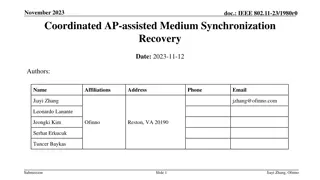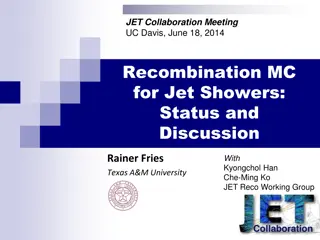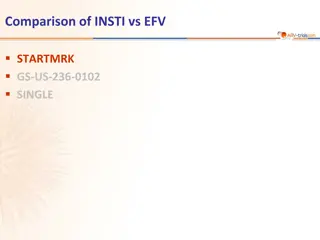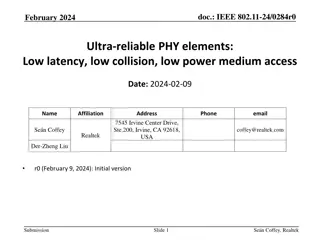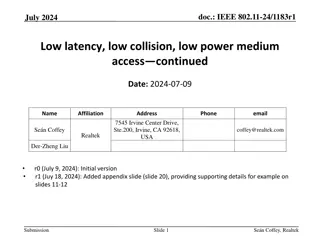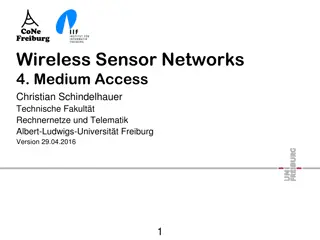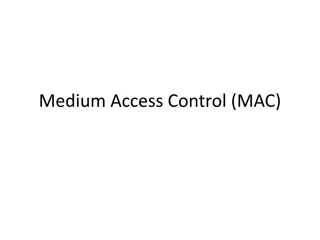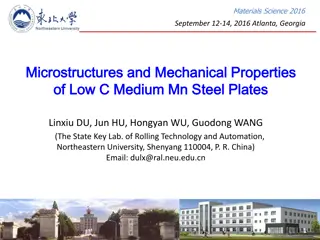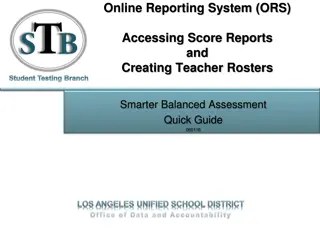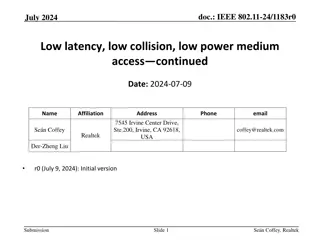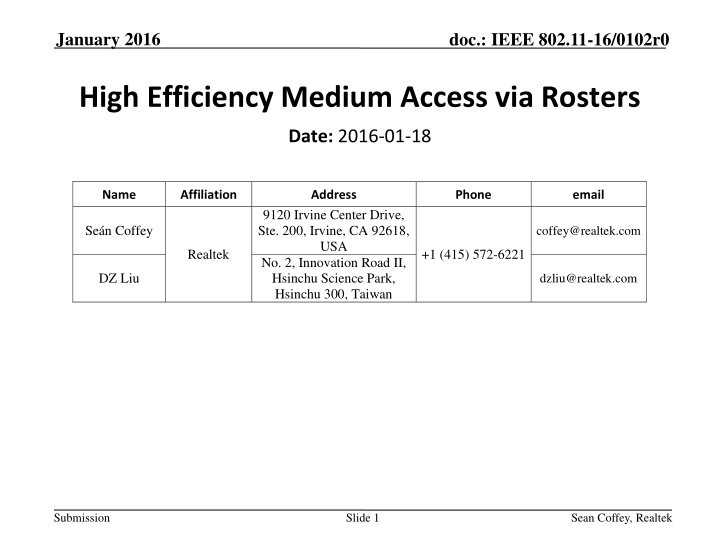
Efficient Medium Access via Rosters in IEEE 802.11-16/0102r0 Presentation
"Discover how using rosters enhances medium access efficiency for 11ax devices in the IEEE 802.11-16/0102r0 presentation. Learn about roster operation fundamentals, addressing hidden nodes, legacy fairness, and more for optimized performance."
Download Presentation

Please find below an Image/Link to download the presentation.
The content on the website is provided AS IS for your information and personal use only. It may not be sold, licensed, or shared on other websites without obtaining consent from the author. If you encounter any issues during the download, it is possible that the publisher has removed the file from their server.
You are allowed to download the files provided on this website for personal or commercial use, subject to the condition that they are used lawfully. All files are the property of their respective owners.
The content on the website is provided AS IS for your information and personal use only. It may not be sold, licensed, or shared on other websites without obtaining consent from the author.
E N D
Presentation Transcript
January 2016 doc.: IEEE 802.11-16/0102r0 High Efficiency Medium Access via Rosters Date: 2016-01-18 Name Affiliation Address Phone email 9120 Irvine Center Drive, Ste. 200, Irvine, CA 92618, USA No. 2, Innovation Road II, Hsinchu Science Park, Hsinchu 300, Taiwan Se n Coffey coffey@realtek.com Realtek +1 (415) 572-6221 DZ Liu dzliu@realtek.com Submission Slide 1 Sean Coffey, Realtek
January 2016 doc.: IEEE 802.11-16/0102r0 Abstract Using rosters reduces medium access overhead, by providing 11ax devices with predictable and unique backoff slots [1, 2]. This presentation provides further information on roster operation, including: A fundamentals of roster operation and contrast with polling methods; B effect of OBSS hidden nodes and a contrast with OFDMA; and C ensuring legacy fairness Submission Slide 2 Sean Coffey, Realtek
January 2016 doc.: IEEE 802.11-16/0102r0 Abstract Using rosters reduces medium access overhead, by providing 11ax devices with predictable and unique backoff slots [1, 2]. This presentation provides further information on roster operation, including: A fundamentals of roster operation and contrast with polling methods; B effect of OBSS hidden nodes and a contrast with OFDMA; and C ensuring legacy fairness Submission Slide 3 Sean Coffey, Realtek
January 2016 doc.: IEEE 802.11-16/0102r0 Motivation I Cf. [1] 43 22 AIFS Backoff CCA +IFS . . . 133 15 AIFS Backoff CCA +IFS RTS SIFS CTS SIFS A-MPDU SIFS BA 43 23 20 15 52 15 44 16 356 16 68 Submission Slide 4 Sean Coffey, Realtek
January 2016 doc.: IEEE 802.11-16/0102r0 Motivation Baseline EDCA medium access overhead = the lower of the two quantities shown Both quantities are usually significant [1] It is possible to achieve much lower medium access overhead than either of these, by re-using well-proven components that are already part of the protocol Submission Slide 5 Sean Coffey, Realtek
January 2016 doc.: IEEE 802.11-16/0102r0 Approach Arrange matters so that each STA may obtain a unique backoff slot Two phases: Build a roster Use the roster Submission Slide 6 Sean Coffey, Realtek
January 2016 doc.: IEEE 802.11-16/0102r0 Using a roster [2, slide 9] (A) AP invokes a roster (now in usage mode): NAV set for legacy devices (say 5 ms) AP If the assigned slot is reached within TXOP, STA may transmit Other devices set NAV and freeze countdown as usual Depicted STA will have frozen its own countdown for each preceding transmission by others STA Roster invoked: Roster number Roster length Current NAV Offset within roster length STA / traffic stream uses its assigned slot(s) modulo offset within roster length Submission Slide 7 Sean Coffey, Realtek
January 2016 doc.: IEEE 802.11-16/0102r0 Using a roster (A) Fundamental operation, step 1/3: AP ? STA On detecting L-STF during 9 s slot time, other devices freeze backoff decrement and prepare for rest of PPDU At beginning, other devices do not know duration of PPDU Submission Slide 8 Sean Coffey, Realtek
January 2016 doc.: IEEE 802.11-16/0102r0 Using a roster (A) Fundamental operation, step 2/3: AP STA Other STAs read further and extract duration from L-SIG, set NAV Submission Slide 9 Sean Coffey, Realtek
January 2016 doc.: IEEE 802.11-16/0102r0 Using a roster (A) Fundamental operation, step 3/3: AP STA STA transmits for signaled duration, and other device defer Submission Slide 10 Sean Coffey, Realtek
January 2016 doc.: IEEE 802.11-16/0102r0 Using a roster (A) Corollary 1: No duration scheduling required at AP AP ? STA AP takes care of order only; STA will announce duration later Submission Slide 11 Sean Coffey, Realtek
January 2016 doc.: IEEE 802.11-16/0102r0 Using a roster (A) Corollary 2: No data to transmit causes only 9 s loss AP Other STAs continue countdown STA May transmit when their turn arrives, earliest 9 s later STA s turn arrives but no data to transmit STA doesn t start transmitting Submission Slide 12 Sean Coffey, Realtek
January 2016 doc.: IEEE 802.11-16/0102r0 Summary A A Fundamentals of roster operation and differences with polling methods: Polling methods require specific duration in advance Polling methods waste airtime (for the full polled duration) if the polled device has no data to transmit Polling methods require extra PPDU(s) when allocated duration is insufficient, wasting airtime from extra preambles & other overhead Rosters have none of these drawbacks Submission Slide 13 Sean Coffey, Realtek
January 2016 doc.: IEEE 802.11-16/0102r0 Abstract Using rosters reduces medium access overhead, by providing 11ax devices with predictable and unique backoff slots [1, 2]. This presentation provides further information on roster operation, including: A fundamentals of roster operation and contrast with polling methods; B effect of OBSS hidden nodes and a contrast with OFDMA; and C ensuring legacy fairness Submission Slide 14 Sean Coffey, Realtek
January 2016 doc.: IEEE 802.11-16/0102r0 Hidden nodes from OBSS [2, slide 15] (B) A-MPDU / Block Ack AP VIFS + slot time (if AP bitmap signaled 0) Later slot: (after a busy slot) STA VIFS + CTS time + SIFS + slot time (if AP bitmap signaled 1) VIFS = Vestigial IFS, say 4 s: for CCA, Rx-to-Tx and Tx-to-Rx turnaround times Submission Slide 15 Sean Coffey, Realtek
January 2016 doc.: IEEE 802.11-16/0102r0 Hidden nodes from OBSS (B) A-MPDU / Block Ack AP CCA checks for OBSS hidden nodes STA gives up slot if CCA high VIFS + slot time (if AP bitmap signaled 0) Later slot: (after a busy slot) STA VIFS + CTS time + SIFS + slot time (if AP bitmap signaled 1) VIFS = Vestigial IFS, say 4 s: for CCA, Rx-to-Tx and Tx-to-Rx turnaround times Submission Slide 16 Sean Coffey, Realtek
January 2016 doc.: IEEE 802.11-16/0102r0 Using a roster (B) Corollary 3: OBSS hidden node causes only 9 s loss AP Other STAs continue countdown STA May transmit when their turn arrives, earliest 9 s later STA s turn arrives but CCA is high: OBSS hidden node (i.e., VIFS + 9 s later) STA doesn t start transmitting Submission Slide 17 Sean Coffey, Realtek
January 2016 doc.: IEEE 802.11-16/0102r0 Summary B B Effect of OBSS hidden nodes and a contrast with OFDMA: Roster methods automatically reallocate airtime if there is an OBSS hidden node Roster methods lose only a minimum airtime (IFS + slot time) when OBSS hidden node transmits Roster moves on to next roster slot which may not have CCA high OFDMA loses full allocated duration with OBSS hidden node Submission Slide 18 Sean Coffey, Realtek
January 2016 doc.: IEEE 802.11-16/0102r0 Abstract Using rosters reduces medium access overhead, by providing 11ax devices with predictable and unique backoff slots [1, 2]. This presentation provides further information on roster operation, including: A fundamentals of roster operation and contrast with polling methods; B effect of OBSS hidden nodes and a contrast with OFDMA; and C ensuring legacy fairness Submission Slide 19 Sean Coffey, Realtek
January 2016 doc.: IEEE 802.11-16/0102r0 Legacy fairness (C) Previously a method was provided to ensure that devices participating in the roster do not achieve an unfair advantage over legacy devices devices defer for an appropriate time after roster use in order to equalize medium access [2, slide x2] Question arose on how the fairness works at AP how does the AP judge when to use roster mode? Using roster mode without guidelines would disadvantage legacy devices key is to have roster mode itself defer after use Submission Slide 20 Sean Coffey, Realtek
January 2016 doc.: IEEE 802.11-16/0102r0 [1, slide 9] (C) Microseconds Subtract 40 s for 24 Mbps Control Rate (RTS 28 s vs. 52; CTS 28 s v. 44) Submission Slide 21 Sean Coffey, Realtek
January 2016 doc.: IEEE 802.11-16/0102r0 (C) Microseconds Backoff time quickly converges to a mean of 21-22 s Submission Slide 22 Sean Coffey, Realtek
January 2016 doc.: IEEE 802.11-16/0102r0 Legacy-fair operation (C) Rosters access the medium under EDCA rules, with high priority VI access category Low CWmax Low retry limit (say 4) Every use of any roster by that AP falls under a single state for EDCA access purposes After a successful roster use, AP defers next use AP does not use any new roster until N x 2.5 backoff slots have expired N= AP s estimate of number of legacy devices that should be allowed to transmit, to equalize channel access Submission Slide 23 Sean Coffey, Realtek
January 2016 doc.: IEEE 802.11-16/0102r0 References [1] IEEE doc. 11/15-1114r1, Airtime Analysis of EDCA , S. Coffey, D.Z. Liu (Realtek), September 2015 [1] IEEE doc. 11/15-1115r1, High Efficiency in Accessing the Medium , S. Coffey, D.Z. Liu (Realtek), September 2015 Submission Slide 24 Sean Coffey, Realtek








